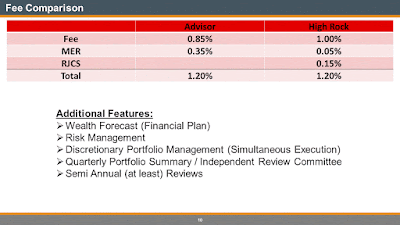Warren Buffett Says Fees Are Too High
We Agree
On February 15, I wrote a blog asking the question: "Are you getting value for what you are paying for?"
In his annual letter to shareholders (released last Saturday), Mr. Buffett took Hedge Funds and expensive money managers to task, suggesting that billions ($100B to use his number) have been surrendered to pay for relatively poor performance over the last decade.
In 2008, he bet that the S&P 500 (using a Vanguard index ETF) would out-perform a collection of "active" fund managers. It did so significantly and his bet winnings will be awarded to a charity of his choosing.
Why did the managers under-perform: fees and fees on top of fees.
Now, we at High Rock use a combination of index ETF's (in our Global Equity model) and individual securities (in our Fixed Income and Tactical models) to reduce MER costs to a bare minimum. That is one source of fees that is embedded or "hidden" and not required by the regulators to be fully divulged in a completely transparent manner. They only require those to be in the "microscopic" fine print at the bottom of a Fund Fact document that is sent when you buy a mutual fund or ETF. Many don't even look at the document, let alone the fine print. We have shown many of our prospective clients the difference on a weighted average basis and it has certainly turned their heads.
Are we "active" managers?
Only partially. We believe that the "average" portfolio manager will fail to "beat" the index that they are compared to for performance. We also think that our skill and deep research will guide us in making good tactical portfolio adjustments and re-balancings (to lower risk).
However, we also believe that Mr. Buffet is correct and at High Rock we always try to minimize fees and have reasonable exposure to the equity indexes for their long-term out-performance.
And don't forget the client service factors as well.
We are "stewards" of our clients wealth and that is what drives our day to day work. It is not just about collecting fees (as Mr. Buffett notes). It is about being paid for doing good work.
Mr. Buffett's letter: (start at page 20)
As part of our ongoing offering to clients, we will conduct a (shorter than usual) regular Tuesday client webinar, but with Mr. Trump's 9pm EST address of the US Congress tonight, there will be plenty of financial market "what ifs" that may alter the current level of volatility and we will spend more time on those details next week.
Tune in to the recorded version if you like: http://highrockcapital.ca/current-edition-of-the-weekly-webinar.html at or about 5pm EST for our latest update.

























